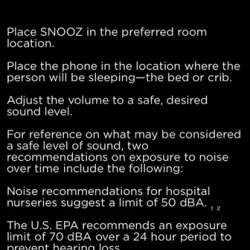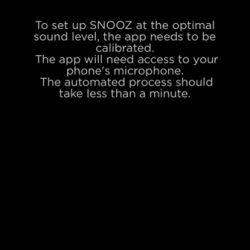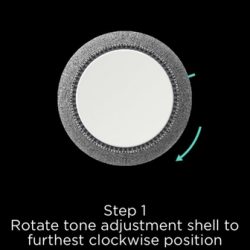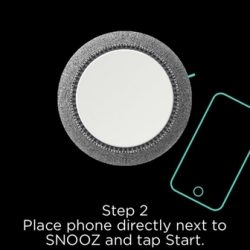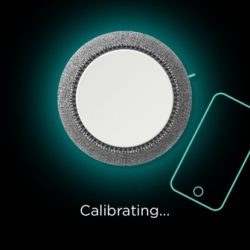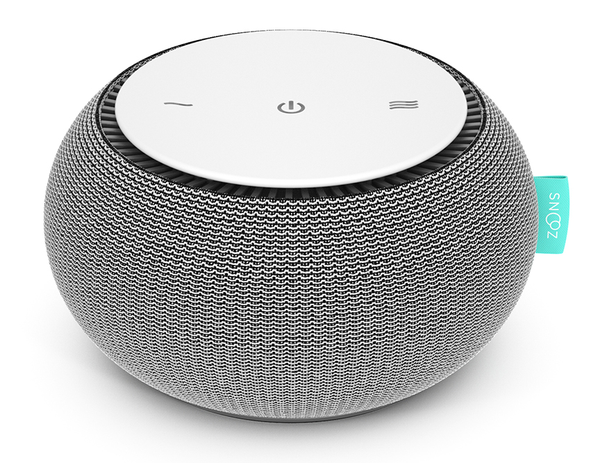
One of humankind’s most under-rated activities is sleep. We cannot function without it and yet the modern world makes it very difficult to fall asleep naturally. Lights, evening activities, foods and drinks with stimulating ingredients, and noise all contribute to shifting and/or shortening our natural sleep cycle. Avoiding lights (especially certain hues), certain foods, activities that get the blood flowing are somewhat in everyone’s own control, but avoiding noises is more difficult. Noise is especially prone to disturb sleep because our hearing is always alert, even while sleeping. White noise machines help because the tones they produce lull our minds into sleep while at the same time drowning out noises which may wake us. One of the most trusted noise machines is a fan running at night. Snooz has turned this old standby into a state-of-the-art gadget. read on to see what I think!
What Is It?
The Snooz is a white noise machine with a real fan used to generate the sound. It has fan design and a low-power motor designed to be energy efficient. It is also controllable by an smartphone app using Bluetooth, so that it can be remotely controlled, programmed to start and stop on schedule, and operated to not exceed a dBA noise level measured at the phone.
Design and Features
Unboxing
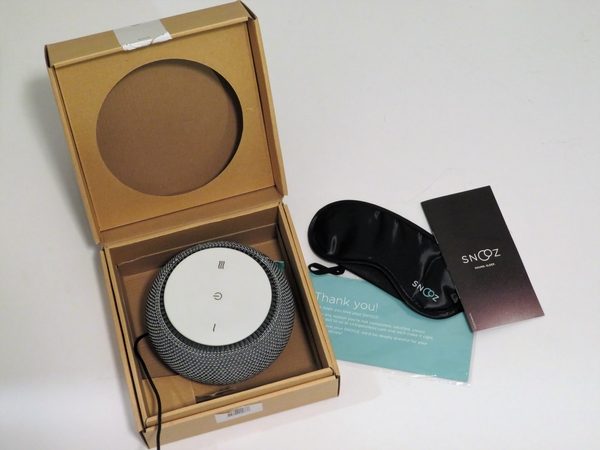
The Snooz comes with a sleeping mask and an instruction booklet. At the back of the booklet is a one year limited warranty against defects in materials and workmanship. The packaging is “frustration-free” style and opens in a clamshell fashion, as depicted above.
The Snooz is just over 5 1/2 inches at its widest part and is about 3 1/4 inches tall, weighing in at 1.1 lbs. This means that it is very easy to pack into a suitcase while traveling.
The outside of the Snooz is made from plastic and covered with a polyester soft mesh wrap.
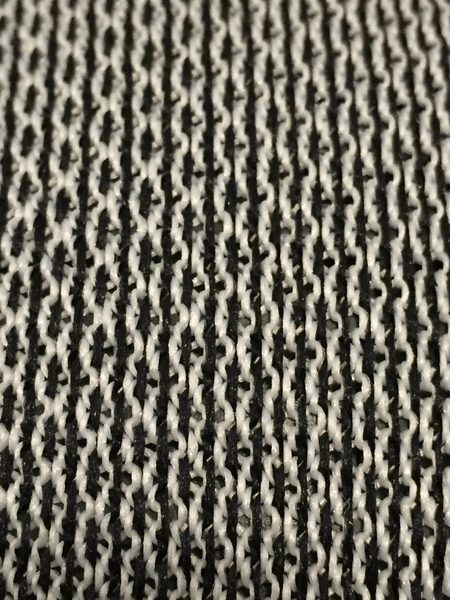
The outside is also adorned with a product label

The polyester covering is also available in charcoal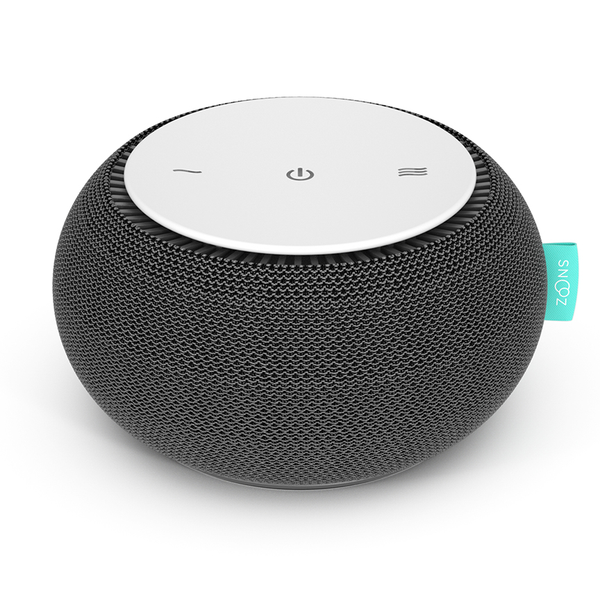
The base of the unit is covered in a soft rubber. The purpose is not only to provide protection to surfaces that it is installed on but to permit rotation of the top of the unit in order to customize the tone of the sound. The power cord is also visible in the picture below at the base of the photo. One thing that I was surprised to see is that the power cord is permanently attached to the base of the unit. This makes it a little harder to install if it is necessary to fish the wall wort attached to the plug behind furniture or through shelves. Having a DC connector may make installation in a room easier but also presents the risk that the plug gets lost.
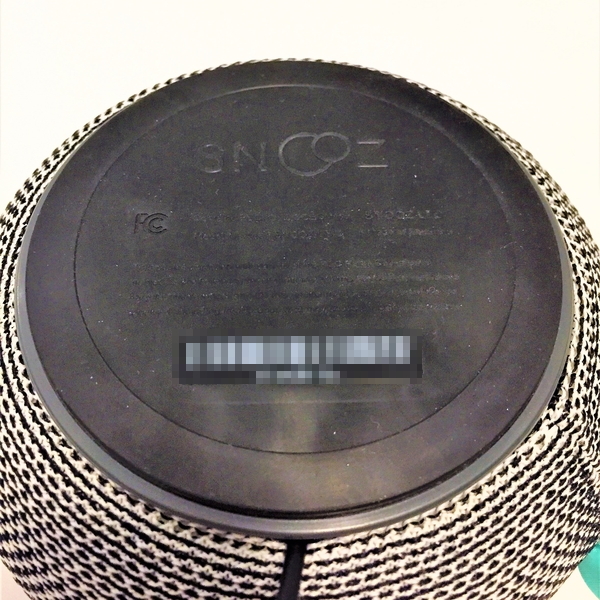
Operation
A normal desk fan has a propeller like impeller that slices the air as it turns, adds pressure, and pushes it toward the direction of the motor. All of this air movement creates turbulence which creates vibrations that people interpret as white noise. A few inventors thought they could improve on this and started a Kickstarter campaign. In the end, 5,799 backers pledged $463,648 to help bring this project to life. In order to see how the Snooz is different than a desk fan requires an inside look. The plastic body of the unit is permanently sealed, but the exploded view below gives a peak into the inner workings of the unit. The Snooz impeller is in the style of a Rushton impeller, which is characterized by moving fluid or air in a radial direction, away from the center of the shaft. The air strikes the inside of the body and causes noise. In a mostly closed container, air that does not exit the unit will circulate around the inside of the container back toward the center and will be recirculated by the impeller once again. This operation is why the noise machine can produce the sound of a fan without creating the large movement of air.
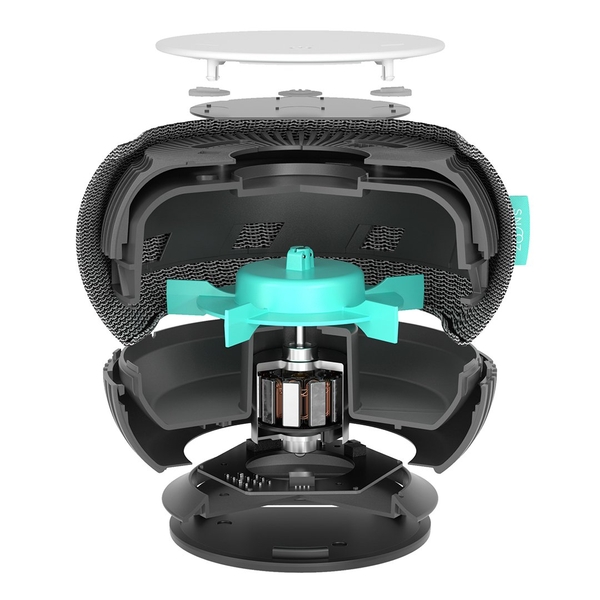
The other big difference between the Snooz and a desk fan is the style and connected operation. The top of the Snooz shows three symbols: a power icon between two icons of moving air, one showing small flow and the other larger.
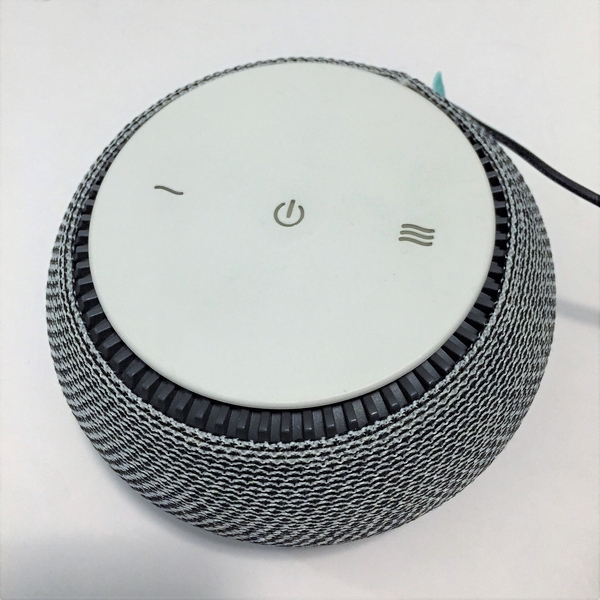
The three icons are capacitive switches and are illuminated by LEDs from below. Gently touching the icons will cause them to illuminate for seven seconds.
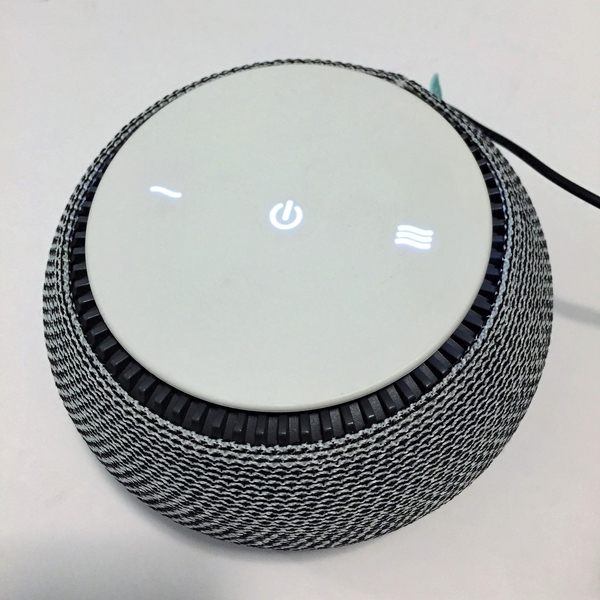
There are ten levels of volume settings ranging from 46 dBA to 87 dBA measured at the device (as reported by the manufacturer). And, as reported above, rotating the shell of the Snooz changes the size of holes in the chamber wall, altering the tone of the sound produced.
One of the most unique features of the Snooz is the Bluetooth connectivity and embedded microcontroller. These features allow the Snooz to be operated remotely and programmed to start and stop automatically. After installing and starting the Snooz app, the first screen that is presented is the pairing screen below.
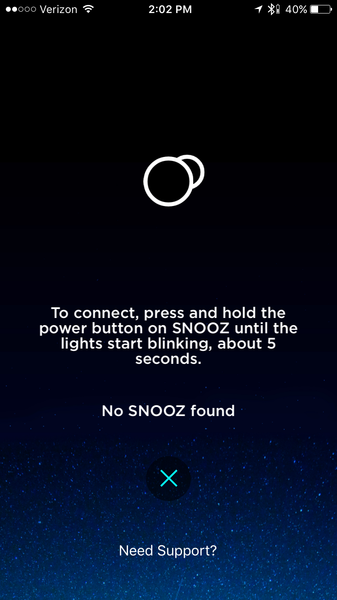
After pairing you can rename the Snooz. I chose to rename it “The Gadgeteer”.
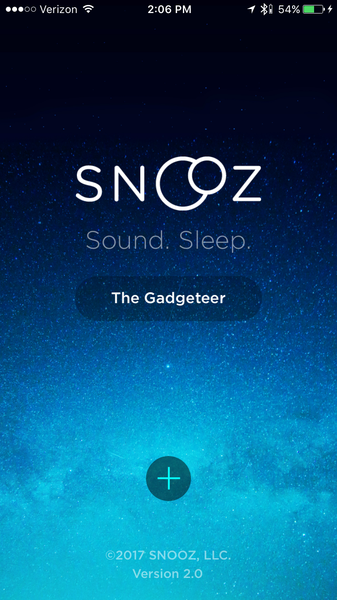
If after pairing the Snooz is unplugged then the following screen will be displayed, but after plugging the unit back in all of the setup data, including the name and the operating schedule, will be restored.
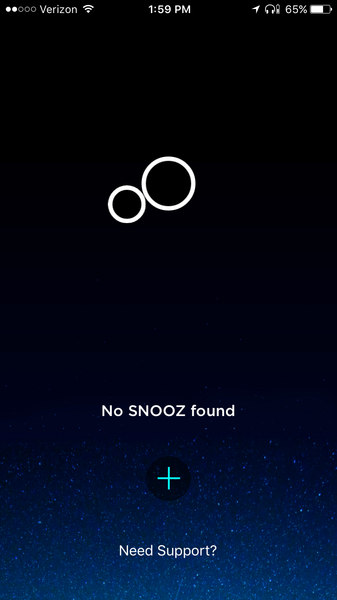
Once connected, operation of the app is straightforward. The same icons on the unit are displayed in the app.
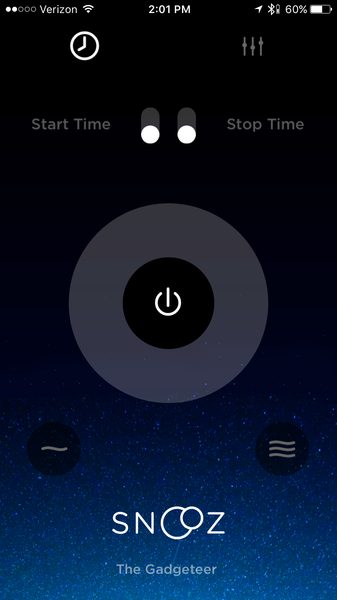
After the unit is powered on, the central ring displays what volume (1-10) the unit is operating at
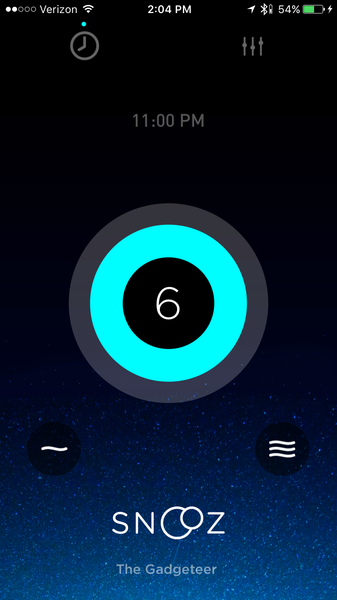
The clock icon to the upper left allows the app to set a start and end time to the snooz.
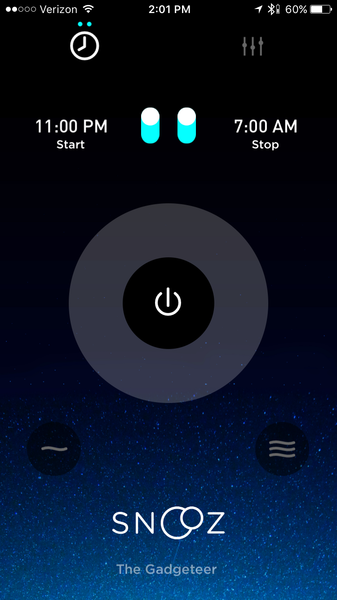
The number of blue dots above the clock indicates the number of automatic settings that are set.
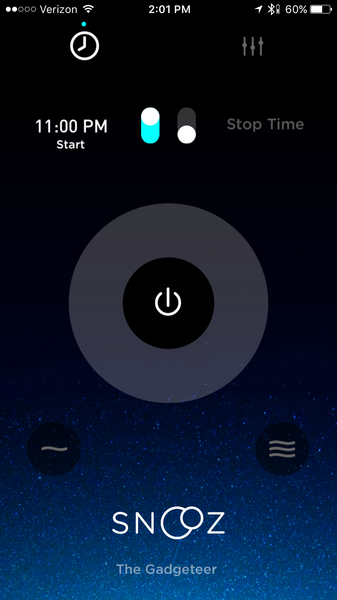
The settings icon on the other side is for using the microphone on the smartphone for ensuring the noise out of the sound machine is below recommended values for noise exposure. Before this feature can be used the microphone on the phone must be calibrated. The app uses the known volume of noise generated by the Snooz to calibrate the microphone on the smartphone. The calibration procedure is demonstrated in the gallery below
After the phone is calibrated it can be used to set the volume of the snooz to produce the indicated dBA at the phone. The image below is just me humming into the microphone but illustrates what the readout on the phone looks like.
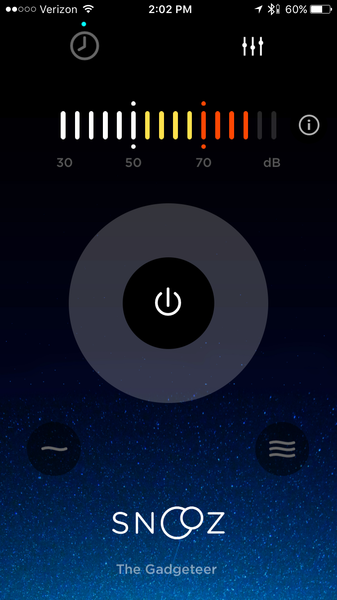
Performance
One of the performance characteristics the Snooz differentiates itself with from a desk fan is the low power consumption it achieves. The Snooz consumes 6 watts at the highest volume. I have two other sound machines in the house, each with a speaker and a recorded track. They have power requirements of about 2.5 watts each. However, these produce 70 – 74 dBA at the device (as measured by the Snooz app) versus 78 next to the Snooz. Therefore the Snooz is either about the same volume or almost twice as loud as devices using about a third of the power.
Positives
- Peaceful white noise from a real fan
- Fully adjustable tone & volume (10 settings)
- Portable design
- Companion app includes remote control, auto-shutoff, and nursery calibration (available for iPhone and Android)
Negatives
- Always connected AC cord
- Still a bit more power hungry than recording based models
Final thoughts
The Snooz is indeed an improvement on the desk fan or some of the less connected or sophisticated stand-alone noise machines. Its features include white noise from a real fan with adjustable tone and volume (10 settings), portable design, and a companion app which includes remote control, auto-shutoff, and nursery calibration (available for iPhone and Android). However, with these features comes a premium price of $79.99. In a world where some people struggle with the luxury of sleep, the Snooz stands out as a luxury sound machine. If the features discussed in this review appeal to you, then the Snooz won’t disappoint.
Price: $79.99
Where to buy: Amazon
Source: The sample of this product was provided by Snooz.

